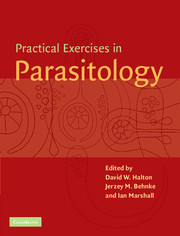Book contents
- Frontmatter
- Contents
- List of contributors
- Preface
- General advice
- 1 Observational Exercises on Parasites
- 2 Ecology
- 2.1 Pin worms (Nematoda, Oxyuroidea) in the American cockroach, Periplaneta americana
- 2.2 Distribution and microhabitat of a monogenean on the gills of mackerel
- 2.3 Population dynamics of Gyrodactylus on stickleback
- 2.4 Intraspecific competition in the cestode Hymenolepis diminuta, in rats
- 2.5 Transmission dynamics and the pattern of dispersion of the cestode Hymenolepis diminuta, in the intermediate host population
- 3 Physiology and Biochemistry
- 4 Pathology and Immunology
- 5 Chemotherapy
- 6 Molecular Parasitology
- 7 Behaviour
- Appendix 1 Reagent index
- Appendix 2 UK suppliers
- Appendix 3 US suppliers
- Index
2.3 - Population dynamics of Gyrodactylus on stickleback
Published online by Cambridge University Press: 05 June 2012
- Frontmatter
- Contents
- List of contributors
- Preface
- General advice
- 1 Observational Exercises on Parasites
- 2 Ecology
- 2.1 Pin worms (Nematoda, Oxyuroidea) in the American cockroach, Periplaneta americana
- 2.2 Distribution and microhabitat of a monogenean on the gills of mackerel
- 2.3 Population dynamics of Gyrodactylus on stickleback
- 2.4 Intraspecific competition in the cestode Hymenolepis diminuta, in rats
- 2.5 Transmission dynamics and the pattern of dispersion of the cestode Hymenolepis diminuta, in the intermediate host population
- 3 Physiology and Biochemistry
- 4 Pathology and Immunology
- 5 Chemotherapy
- 6 Molecular Parasitology
- 7 Behaviour
- Appendix 1 Reagent index
- Appendix 2 UK suppliers
- Appendix 3 US suppliers
- Index
Summary
Aims and objectives
This exercise is designed to demonstrate:
The dynamic interactions occurring between host and parasite under the influence of external environmental conditions.
The balance that exists in the host-parasite relationship between the potential for parasite-induced pathogenic damage, including host death, and the capacity of the host response to regulate infection levels.
The value of numerical data with which to develop an understanding of the distribution of parasite populations within host populations (and the significance for transmission, pathology, etc).
Adaptation to parasitism, the skills and patience required for manipulation, and the rewards of microscopic examination.
Introduction
Assessment of infection levels in the host (and host population) provides important information on the success of the parasite life cycle, the severity of pathogenic effects on the host, and the effectiveness of host immunity. Combined with information on parasite age and developmental rate, infection levels may also enable reconstruction of the recent history of recruitment of parasites into the individual host and population: current infection levels reflect successful parasite invasion moderated by the host defensive response and other influences such as competition. Measurement of infection levels, however, represents only a ‘snapshot’ of the dynamic processes that may affect the host-parasite interaction. The illustration of dramatic fluctuations in parasite numbers within individual hosts can be observed in microparasite infections multiplying and being moderated in situ, as in the cycles of parasitaemia of trypanosomes.
Information
- Type
- Chapter
- Information
- Practical Exercises in Parasitology , pp. 147 - 160Publisher: Cambridge University PressPrint publication year: 2001
